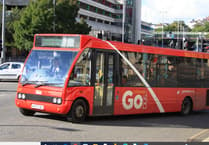FOLLOWING criticism over the proposed closure of NatWest branches in Holsworthy and Bude, the banking group has validated its reasons.
On June 4 the Bude branch is set to close, followed by the Holsworthy branch on June 14.
NatWest stated that since 2012 the way in which people used the Bude and Holsworthy branches has changed drastically. Results show that 54 customers visit the Bude branch on a weekly basis and only 46 for the Holsworthy branch.
However, Christopher Darwin, from Bridgerule, raised his concerns over these figures, calling them ‘ridiculous statistics’ and stating that many people ‘use shops, banks and other businesses less frequently than every week of the year, yet these business are clearly commercially successful’.
Mr Darwin contacted the local chief executive of NatWest, Mr Steve Aldridge, to query these figures. He said: “NatWest/Royal Bank of Scotland management claim that only 46 customers visit the Holsworthy branch of NatWest, and 54 the Bude branch, ‘on a weekly basis’.
“According to Mr Steve Aldridge, local chief executive officer of NatWest, to whom I spoke earlier this month [December], ‘on a weekly basis’ means at least once a week, each of the 52 weeks of the year — no gaps. These are ridiculous statistics.”
Since 2012 the Bude branch has seen 82% of its customers bank in other ways locally while 59% of customers have chosen to bank digitally on a regular basis. Holsworthy’s results are similar with 81% of customers banking in other ways since 2012 and 55% of customers choosing to go down the online banking route.
Mr Darwin disputes these claims and says there are many who still want the option to bank ‘face-to-face’. He said: “Many of us wish to deal with our financial affairs — from paying bills to arranging loans — face-to-face, not online or by telephone.”
In response to concerns over weekly usage of its Holsworthy and Bude branches, a spokesperson for NatWest said: “Before making the decision to close a branch we look at customer usage and the availability and suitability of alternative ways to bank for branch users who live locally or travel to use the branch. We define branch population by looking at the number of customers who actively use the branch and not by how many customers hold an account there.”
When it comes to alternative banking, NatWest are assuring its customers that other provisions have been put in place, including its new ‘community banker’ service. The spokesperson for NatWest said: “We are the only bank which gives six months notice to ensure we can have individual conversations with customers to find the best solution for them, dependent on the services they need and how they prefer to bank. As part of this, to deliver additional face-to-face support for our customers, we will be introducing a ‘community banker’ service.
“Our community banker will be based locally and will be able to provide personal assistance and support to customers to access our non-cash services, as well as help with achieving their financial plans and goals. They will engage with local groups, provide training and education on issues such as fraud and scam prevention in the local area, as well as looking to provide financial education in local schools. We will also be introducing a mobile bank service to the area.”
The spokesperson also made assurances that some of the services being lost by the closure of the branches will be taken on by local Post Offices and that staff will do what they can to help its customers during the transition. The spokeperson said: “Our contract with the Post Office enables our customers to access simple banking transactions such as depositing cash and cheques with a pre-printed pay-in slip, withdrawing cash and obtaining a balance using their debit card. Our business customers can also obtain change. We have many examples of where our local CEO and branch managers have personally taken our customers to the Post Office to introduce them to the staff there and assist with transactions.”

.jpeg?width=209&height=140&crop=209:145,smart&quality=75)

